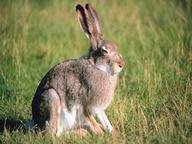Quiz Answer Key and Fun Facts
1. Romerolagus diazi is the world's second smallest species of rabbit and is endemic to the slopes of El Pelado, Iztaccihuatl, Popocatepetl and Tlaloc in central Mexico. By what common name, inspired by its habitat, is this rabbit best known?
2. Which of the following options is a species of pika that lives in the semi-arid grasslands of southern Russia and northern Kazakhstan?
3. Lepus arcticus, otherwise known as the Arctic hare, is one of the world's largest lagomorphs. It can be found in the arctic regions of which countries?
4. The swamp rabbit has an alternative name that is probably derived from the way it applies its teeth to its favourite dinner of plants like grasses, saplings and shrubs. What is it?
5. Which hare with the Latin name Lepus timidus is the only lagomorph that is native to Great Britain?
6. Like all other cottontail rabbits, the desert cottontail has a distinctive method of eating its food. Which of the following best describes it?
7. The scrub hare, Lepus saxatilis, is endemic to the scrublands, grasslands and wooded areas of the southern part of which continent?
8. The plateau pika lives at high altitude on the Tibetan plateau and nearby regions. Which of the following is the Latin name for this lagomorph?
9. Lepus microtis, the African savanna hare, is noted for its distinctive grooved teeth. Like many other species of lagomorphs they often practice coprophagy, which means that they put their teeth to use eating what?
10. The riverine rabbit, also known as the bushman rabbit or bushman hare, has an unusual characteristic for a rabbit. Which of these options is true of this species?
Source: Author
Fifiona81
This quiz was reviewed by FunTrivia editor
guitargoddess before going online.
Any errors found in FunTrivia content are routinely corrected through our feedback system.

